August 2, 2025 | 18:49 GMT +7
August 2, 2025 | 18:49 GMT +7
Hotline: 0913.378.918
August 2, 2025 | 18:49 GMT +7
Hotline: 0913.378.918
On December 15, the Vietnam Fish Sauce Association in collaboration with the Vietnam Fisheries Society and the Research Institute for Marine Fishery (RIFF) under the Ministry of Agriculture and Rural Development (MARD) held a workshop on "Protecting fish resources and sustainably developing fish sauce production in Vietnam".

MARD Deputy Minister Phung Duc Tien speaks at the workshop. Photo: Minh Phuc.
For any products, especially those related to food, input materials are extremely important. In the fish sauce industry, maintaining fishing and processing activities is a prerequisite for its development.
Speaking at the workshop, MARD Deputy Minister Phung Duc Tien emphasized: “To have fish sauce, there must be fish. To have fish, it is necessary to breed, exploit and conserve it. These three pillars cannot be separated.”
According to Tien, by 2030, the fishing output will be reduced to only 2.8 million tons while aquaculture production will reach 7 million tons because the current fishing intensity is too great.
According to data issued by the General Statistics Office, Vietnam’s fish sauce productivity in 2020 reached nearly 280 million liters with average consumption is about 3.9 liters/person/year. The annual export value is about USD25 million.

Delegates contribute many ideas to build and sustainably develop the country’s fish sauce industry. Photo: Minh Phuc.
Mr. Dinh Xuan Lap, Deputy Director of the Center for International Cooperation in Aquaculture and Sustainable Fisheries (ICAFIS) under the Vietnam Fisheries Society said: “To export fish sauce, our products must meet the requirements of each market. Typically, the US requires them to meet standards of the FDA (US Food and Drug Administration), following the principles of a food safety management system (HACCP). The European market is strictly controlling them following the Histamine standards while Japan, China, and Korea all have high requirements for product quality and import quality safety permits.
In particular, import countries are more and more demanding to combat illegal, unregulated and unreported (IUU) fishing.

Mr. Dinh Xuan Lap, Deputy Director of ICAFIS under the Vietnam Fisheries Society. Photo: Minh Phuc.
“Decision 1005 of the EC also stated that fishery products, as well as those derived from sea products exported to Europe, must have a certificate for IUU practice. The US market also has programs to control fishery products of which, IUU is a must requirement", Mr. Lap emphasized.
Therefore, along with hygienic and human health protection requirements, the fish sauce industry must be “responsible” for the fishing industry. This is the common roadmap and also Vietnam's commitment to the international market.
According to Lap, Vietnam's fish sauce production industry has a strength of abundant material source with 2.45 million tons. The fishing industry has a 500-600-year history with high skilled fishing forces. In addition, the exploitation has formed a link from fishing to processing, with our country's fish sauce product being evaluated as rich in nutrients and protein.
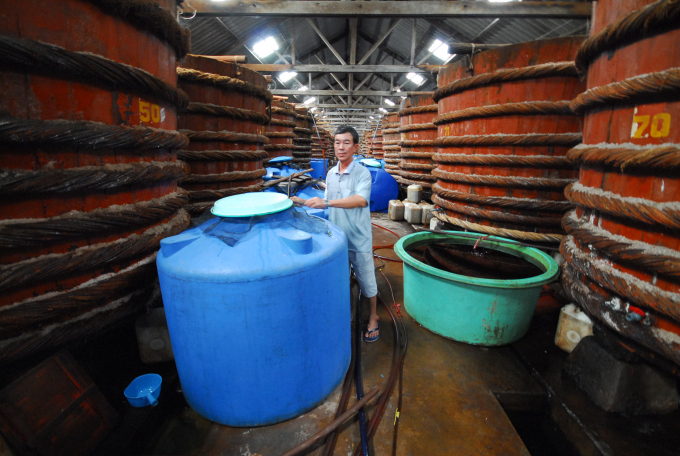
Vietnam's fish sauce production has many opportunities to reach the world markets. Photo: NNVN.
However, the industry has a weakness in post-harvest preservation which is now still limited with the uncontrolled Histamine. Although there is a link, it is still loose and not tight. The whole country has 783 production units and 1,500 households engaged in making fish sauce, however, many of them have not fully ensured food hygienic and safety conditions such as the HACCP and ISO.
In addition, our country's fishing vessels near the coastal areas are not fully installed with equipment according to IUU regulations, specifically the fishing vessel monitoring system. Fishing boats are still small-scaled and the exploitation cost is high. Meanwhile, fishery resources near coastal areas are increasingly depleted due to environmental issues and climate change.
Regarding the opportunity to export fish sauce, Mr. Lap said Vietnam so far has signed 13 free trade agreements, so this has provided opportunities for business and fish sauce production to get connectivity as well as for exports. MARD, the Ministry of Health, and the Ministry of Industry and Trade should pay attention to support aquatic products and fish sauce production. Western customers have become interested in Vietnamese fish sauce, which is a huge opportunity for the country.
To develop the fish sauce industry, he suggested that it is necessary to establish community-based resource management models, towards sustainable exploitation of aquatic resources based on the fisheries associations, at the same time, strengthen links with the Fish Sauce Association to promote the development and bring Vietnamese fish sauce to the world.
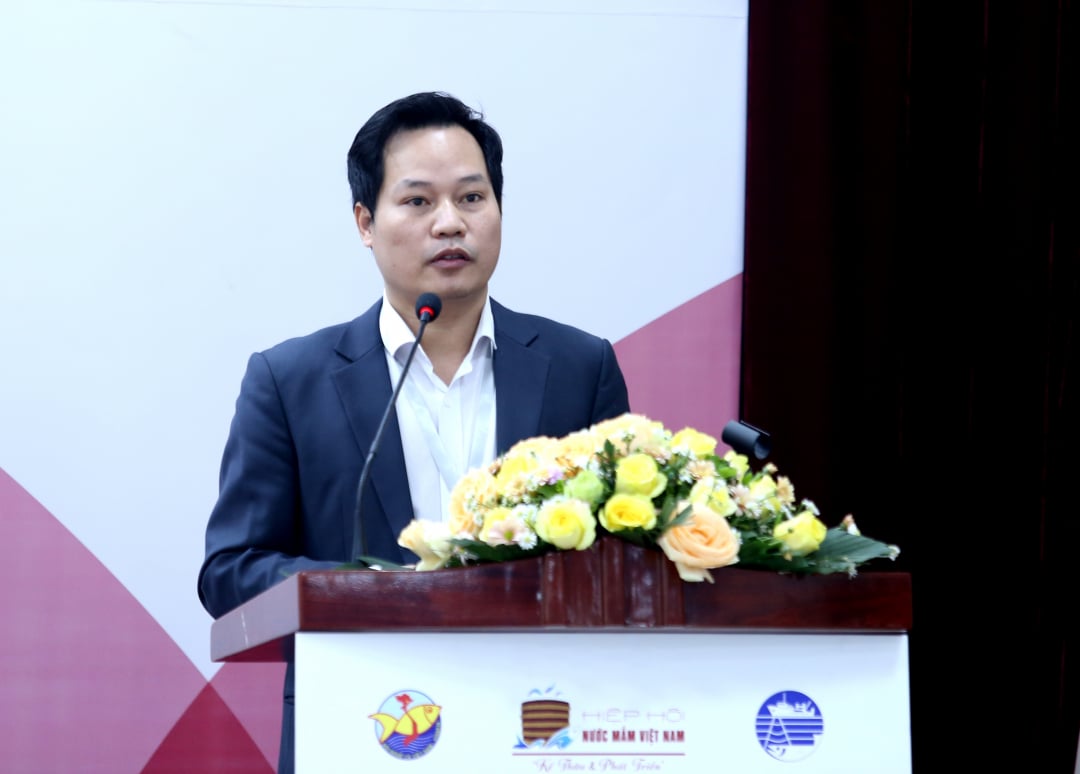
A representative from the RIFF speaks at the workshop. Photo: Minh Phuc.
According to the RIFF, in our country, the main raw materials for fish sauce production is a group of small fish with a reserve of about 2.45 million tons, especially scad, herrings, and anchovies. The scad is predominant in the Gulf of Tonkin and the Central region, anchovies dominate in the Southwest region and part of the North Central region, and herrings are scattered throughout the coastal areas with high density in the Gulf of Tonkin.
However, Vietnam's marine resources are being over-exploited and currently declining. To protect and sustainably develop seafood resources, the fish sauce industry needs to find other marine sources with nutritional value to replace the declining anchovies.
Especially, it should focus on studying biological characteristics of seafood species, to determine their location of spawning, breeding grounds, and seasons so that to protect the marine resources (including the prohibition, restriction, and time limit for exploitation).
Translated by Linh Nguyen
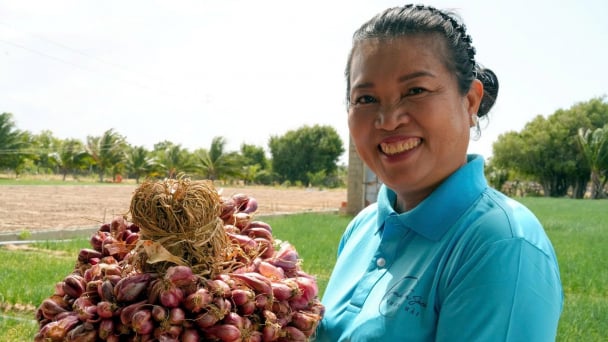
(VAN) The Nhon Hai Purple Shallot Agricultural Cooperative recently began exporting about 3 tons of shallots weekly, becoming the first in the former Ninh Thuan province to do so.
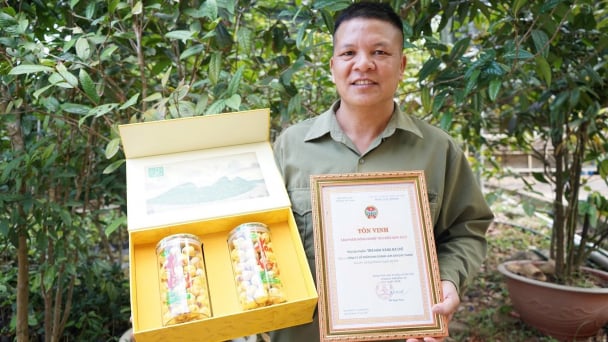
(VAN) OCOP products from Quang Ninh are gradually reaching international markets, with a focus on nationally certified 5-star products.
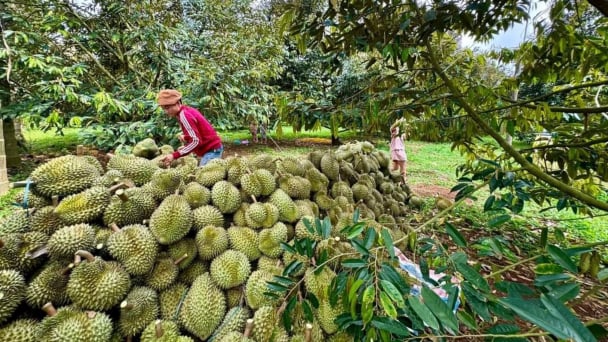
(VAN) After a sharp decline in the early months of the year, Vietnam's durian exports are experiencing a strong recovery, driving the overall rebound in fruit and vegetable exports.

(VAN) The volume of durians imported through Guangxi has surged as the region invests in logistics infrastructure and takes advantage of tariff incentives from the RCEP agreement between China and ASEAN.
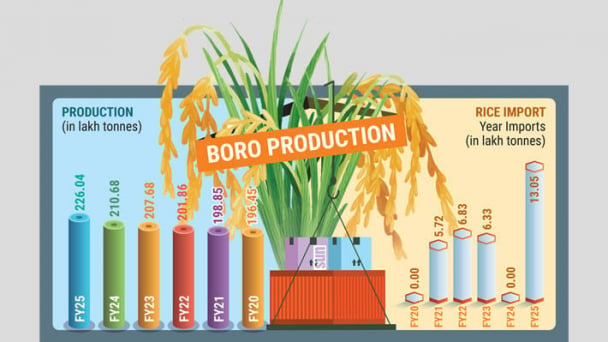
(VAN) Rice prices in Bangladesh have shot up over the past year, rising by as much as 16%, despite a record-breaking harvest this season and large volumes of imports in 2024-25 fiscal year.
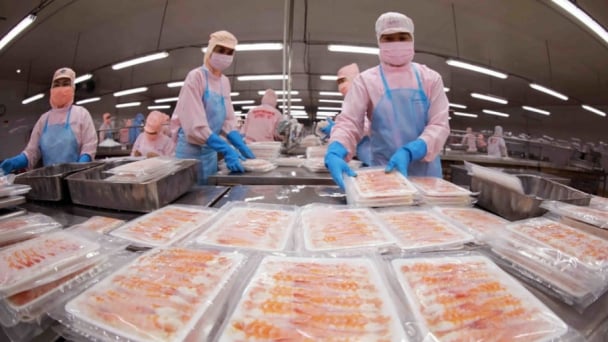
(VAN) U.S. seafood tariffs trigger major disruptions in global supply chains. Vietnam proactively shifts markets and strengthens internal capacity to maintain its export position.
/2025/07/26/1437-0-nongnghiep-221433.jpg)
(VAN) To achieve successful exports, Vietnamese agricultural products must tell a product story that aligns with current trends and reaches to the needs and emotions of international consumers.